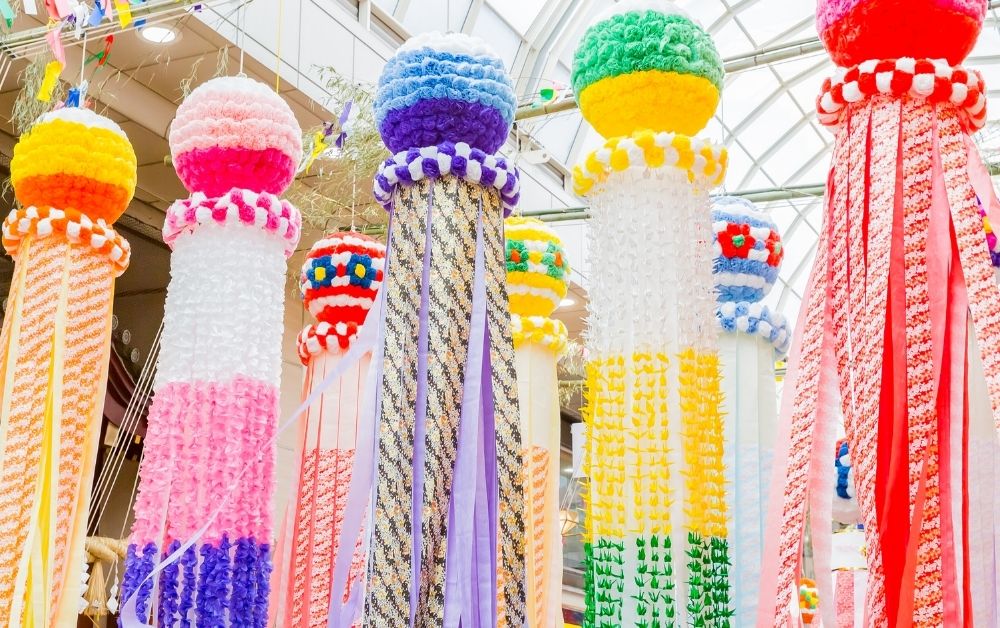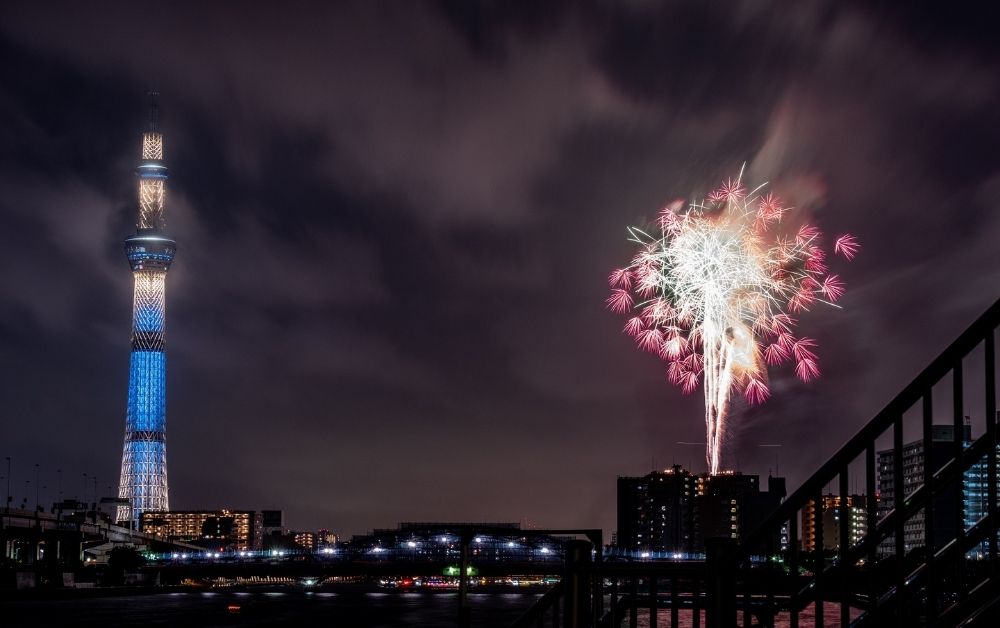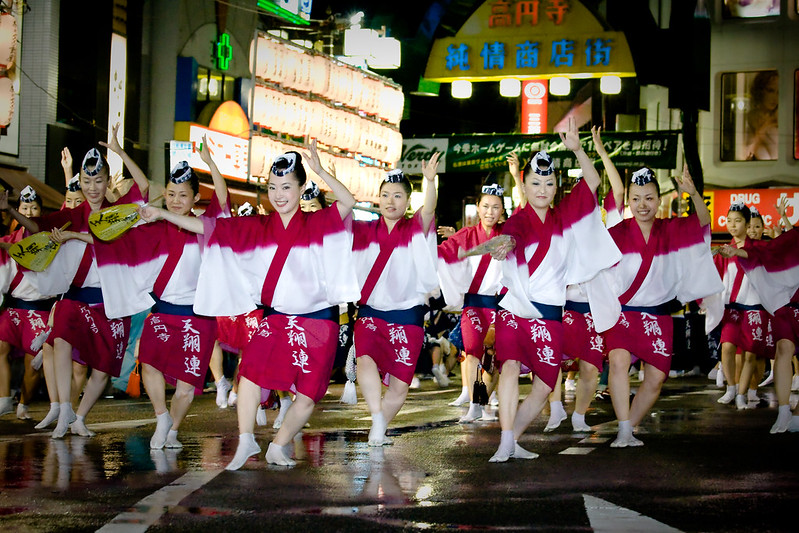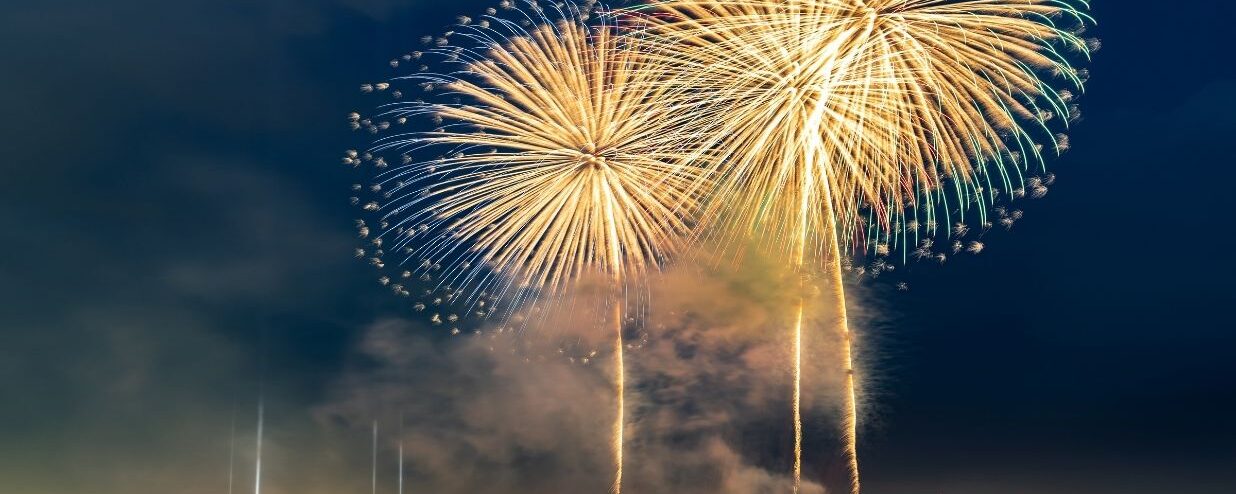Summer in Tokyo is characterized by the unrelenting heat and humidity, but as we head into the evening, the sun starts to set beneath the canvas and the summer festivals light up the evening sky with fireworks, floats, and food stalls. Summer festivals in Tokyo has arrived. Backed by centuries of history, you can expect this period to be filled with dances, music, and other customs.
Tokyo summer may be as hot as it is humid, but the summer festivals or 夏祭り(natsu matsuri) prove the season is a time for celebration and tradition. So, when are the summer festivals in Tokyo, and where can you find them? How many are there in Tokyo? Read our full guide here!
What is a 夏祭り(Natsu Matsuri)?
夏祭り(natsu matsuri), with 夏 (natsu) meaning summer and 祭り(matsuri) translating to festival, are any Japanese festivals taking place during the summer.
Summer festivals often feature vibrant street food stalls called 屋台 (yatai), fireworks, traditional dances, and music. It is common to wear a 浴衣 (yukata) or a 甚平 (jinbei), which are both traditional Japanese robes worn in the summer due to their lighter material compared to winter kimonos. Think of summer matsuri as a wonderful blend of tradition and entertainment.
Many matsuri will have unique characteristics or traditions that have been preserved for many years. It is common for summer festivals to feature 神輿 (mikoshi) or large portable shrines that are carried through the streets and roads. Some of the most popular festivals are known for their flashy, ornamental floats.
お盆祭り (Obon Matsuri)
The お盆 (obon) festival is meant to bring families together in order to honor and celebrate the past lives of their ancestors. Usually, during this season, people living in big cities like Tokyo will return to their family home if they grew up outside the city. This is so you can welcome your ancestors and deceased family into your home, since during the Obon, your ancestors visit from the afterlife. The whole purpose of Obon is to spend time with your family, pray for the peace of your ancestors, and remember the dearly departed.
Festivals usually feature entertainment, games, yatai food stalls, and even rides. In certain rural regions, they may float lit lanterns along the river.
When is summer in Tokyo?
Summer in Tokyo typically starts from June and ends in August. During this time, you will find a lot of festivals, some of the most historic being the 七夕 (tanabata) and the お盆 (obon) festival.
Summer festivals located in Tokyo
So, where can we find Tokyo summer festivals throughout Tokyo? We provided some of the most popular natsu matsuri you should catch during the summer season, whether you’re living in Tokyo or planning to visit in the summer.
1. Shitamachi Tanabata Matsuri (下町七夕祭り)
七夕(tanabata) with 七 (nana) meaning seven and 夕(yuu) meaning evening, literally translates evening of the 7th, which is due to the Tanabata taking place on the 7th day of the 7th month (July). The Tanabata is rooted in the ancient Chinese Qixi Festival, which celebrates the mythological love story between a princess weaver and a cowherd.
The Shitamachi Tanabata Matsuri is a 4-day Tanabata festival in early July. It takes place along the Kappabashi Street, which stretches across Ueno and Asakusa. The whole path of the festival is lit up with traditional performances, food stalls, and trees filled with colorful papers written with people’s wishes. As part of the Tanabata tradition, you can also write your wishes on the paper and tie it to the tree.
The festival also features an excellent view of Tokyo Tower as a backdrop to the festive atmosphere. The view accompanies the 1.2 km stroll, where you can wear a yukata, soak in the festive atmosphere, and visit the shrine for the special Tanabata stamp.
Time: Early July (4 – 5 days)
Where: Kappabashi Dori
Cost: Free Entry
2. Asagaya Tanabata Matsuri (阿佐ヶ谷七夕祭り)

Taking place in the Asagaya Pearl Center Shopping Street, the Asagaya Tanabata Matsuri is famous for its quirky handmade papier-mâché decorations hanging in the shotengai (covered shopping street). Expect giant anime characters, animals, and colorful streamers alongside Tanabata wishes.
The festival has a friendly, local vibe with plenty of snacks and games. The festival has come to be a local favorite in western Tokyo and is growing in popularity.
Time: Early August
Where: Asagaya Pearl Shopping Street
Cost: Free Entry
3. Sumida River Fireworks Festival (隅田川花火大会)

One of Tokyo’s biggest summer events, this fireworks show dates back to the Edo period, likely one of the oldest traditions of fireworks on record. Held along the Sumida River, the night sky bursts with tens of thousands of fireworks while yukata-clad visitors picnic on the riverbanks. Expect crowds; over a million people attend, so arrive early for a good view.
Time: Late July
Where: Fireworks can be viewed in many areas around Asakusa and Tokyo Skytree.
Cost: Free Entry
4. Koenji Awa Odori (高円寺阿波おどり)

The Koenji Awa Odori is an obon festival with a unique dance featuring a Tokyo spin on Tokushima’s famous dance festival. Hundreds of dancers parade through Koenji’s shopping streets, chanting “Yatto sa!” to the beat of shamisen, drums, and flutes. The high-energy moves and colorful costumes turn the neighborhood into one giant party.
Time: Late August
Where: Koenji Station
Cost: Free Entry
5. Sanno Matsuri (山王祭)

One of Tokyo’s three great festivals, held at Hie Shrine. The highlight is the grand Shinkosai parade, where mikoshi (portable shrines) and richly decorated floats wind their way through central Tokyo, including near the Imperial Palace. It’s a more elegant and formal festival compared to the lively Kanda Matsuri.
Time: Mid-June (even-numbered years)
Where: Hie Shrine
Cost: Free Entry
6. Kanda Matsuri (神田祭)

Alternating years with Sanno Matsuri, the Kanda Matsuri centers around Kanda Myoujin Shrine. The festival features massive mikoshi processions through the streets of Chiyoda and Chuo Wards, samurai-themed parades, and traditional music. Historically, it was a way to celebrate Tokugawa shogunate victories, so it has a more boisterous feel.
Time: Mid-May (in odd-numbered years)
Where: Kanda Myojin Shrine
Cost: Free Entry
7. Mitama Matsuri (みたままつり)
Mitama Matsuri features over 30,000 bright yellow lanterns that line the shrine’s long approach, creating a breathtaking, glowing tunnel at night. These lanterns, donated by individuals and businesses, symbolize prayers for the spirits. The festival was first celebrated in 1947 and has become one of the largest Obon-related festivals in Japan, dedicated to honoring the spirits of the deceased. Alongside the solemn memorial aspect, there are food stalls, Bon odori dances, and festival games, blending commemoration with celebration.
Time: Mid-July
Where: Yasukuni Shrine
Cost: Free Entry
Summer festivals around Tokyo
Summer in Tokyo can be hot and humid, and crowded festivals might feel overwhelming. Luckily, regions around Tokyo often offer cooler temperatures and more comfortable conditions, so you can enjoy matsuri without the stress.
1. Sawara Grand Festival (佐原の大祭 夏祭り)
Nestled in the historic streets of Sawara, a well-preserved Edo-era town in Katori City, this summer matsuri is one of the three major float festivals in the Kantou region. It has earned the distinction of being a UNESCO Intangible Cultural Heritage and is also a Nationally Designated Important Intangible Folk Cultural Property.
The highlight is the “nonoji-mawari”: a dramatic performance where floats spin in tight circles as if drawing the Japanese character “の” in the air. Against the backdrop of historic architecture and traditional music, the festival feels like a living pageant of cultural expression.
When: Friday to Sunday after July 10, typically falling around July 11–13
Where: Centered around Yasaka Shrine (Sawara). Around 10 minutes from JR Sawara Station
Cost: Free entry
2. Kamakura Firework Festival (鎌倉花火祭り)

Located near Southern Kanagawa, Kamakura hosts many seasonal festivals tied to historic temples and shrines; however, its annual fireworks festival takes place on the Yeh beaches at Yuigahama and Zaimokuza, providing a scenic coastal backdrop which makes this event unique since most others are based around shrines.
The festival boasts 2,500 fireworks, including special “underwater fireworks” launched from boats that create mesmerizing reflections across the waves. Although not the largest of the summer festivals, its historic coastal setting and artistic staging give it a distinct charm worth visiting.
Time: August 10 (or following Monday, if weekend)
Where: Yuigahama and Zaimokuza
Cost: Free Entry
3. Kumagaya Uchiwa Matsuri (熊谷うちわ祭)
A four-day summer festival in Kumagaya City. Named for the fan (“uchiwa”) tradition of distributing them during the Meiji era. The matsuri’s main attraction is the 12 festival floats, called dashi, pulled through the streets in competing groups, accompanied by rhythmic drumming (ohayashi) and the sound of hand gongs.
The festival attracts hundreds of thousands of attendees (this year there were over 750,000. It is one of Kanto’s largest summer events, attracting people from across Japan to enjoy vibrant street food, toys, and festival stalls lining the route.
Time: Mid-July
Where: Centered around Kumagaya city streets
Cost: Free Entry
Experiencing Tokyo’s summer festival by understanding
Summer festivals in Tokyo are always a great way to see the city beyond its high-tech facade, whether you join in the dances, appreciate towering floats, or simply wander among lantern-lit streets.
Part of living in Japan is engaging in the rich cultural summer festivals, but knowing how to speak Japanese will help to make the most out of the experience. Ready to start learning Japanese? Check out our in-person or online courses offered at Coto Academy! Known for our fun, flexible lessons, you can join a community of 15,000 learners and learn practical Japanese.
Fill out our contact form below for a free Japanese level check and course consultation.
FAQ:
What is a natsu matsuri?
Natsu matsuri (夏祭り) means “summer festival” in Japanese. These events are held across Japan, usually from June to September, often featuring traditional performances, parades, fireworks, and food stalls.
When are summer festivals usually held?
Most take place between July and August, though some begin in late June or continue into early September, depending on the region.
Are all summer festivals the same?
While many share elements like yatai food stalls and yukata attire, each festival has unique attractions or traditions, such as dancing in Tokushima’s Awa Odori, bamboo lantern balancing in Akita’s Kanto Matsuri, or massive float parades in Kyoto’s Gion Matsuri.
Do I have to pay to attend?
Most festivals are free to enter. However, certain seating areas for parades or fireworks may require paid tickets. Also, some do have paid events and performances.
What should I wear to a summer festival?
Many people wear yukata (a light cotton kimono) or jimbei (a light robe top with shorts). However, comfortable summer clothing, like a t-shirt and shorts, is also commonly worn. Light footwear is best since you’ll be walking and standing a lot.
What’s the best way to find local summer festivals?
Check local tourism websites, city event calendars, local poster boards at parks/public areas, or train station information counters. Many festivals are well-advertised locally.
Are more rural regional festivals different from festivals in larger cities?
Just because the festival is held away from larger cities like Tokyo or Kyoto doesn’t mean it will be smaller or quieter. The atmosphere can range from simple, intimate events with a few hundred attendees featuring local dances and shrine rituals to massive, nationally renowned spectacles like Aomori’s Nebuta Matsuri. Scale often depends on historical significance, local tourism goals, and city size.
Love our content and want to explore Japan? Read our guide on:
